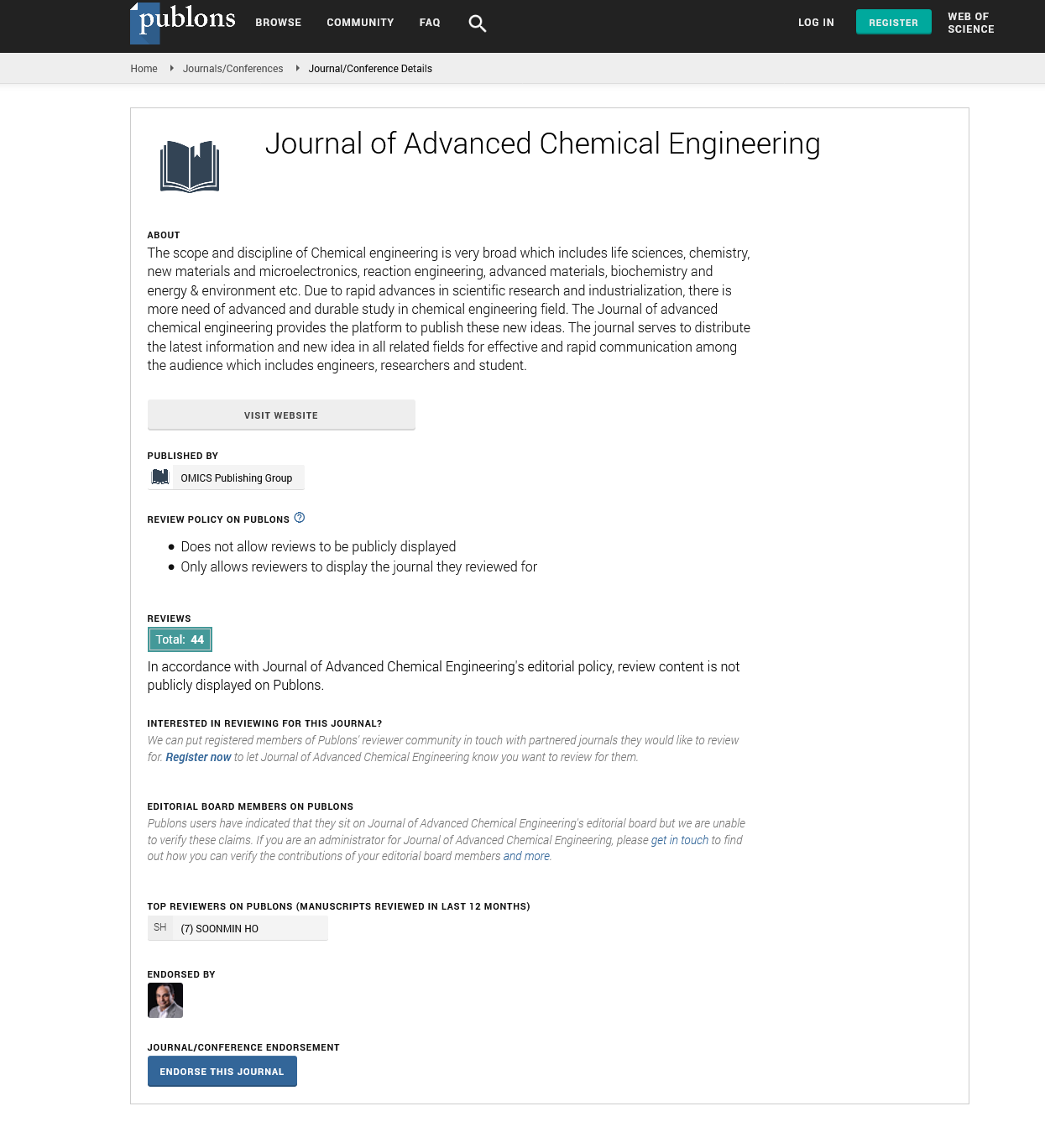Indexed In
- Open J Gate
- Genamics JournalSeek
- Smithers Rapra
- RefSeek
- Directory of Research Journal Indexing (DRJI)
- Hamdard University
- EBSCO A-Z
- OCLC- WorldCat
- Scholarsteer
- Publons
- Geneva Foundation for Medical Education and Research
- Google Scholar
Useful Links
Share This Page
Journal Flyer

Open Access Journals
- Agri and Aquaculture
- Biochemistry
- Bioinformatics & Systems Biology
- Business & Management
- Chemistry
- Clinical Sciences
- Engineering
- Food & Nutrition
- General Science
- Genetics & Molecular Biology
- Immunology & Microbiology
- Medical Sciences
- Neuroscience & Psychology
- Nursing & Health Care
- Pharmaceutical Sciences
Opinion Article - (2022) Volume 12, Issue 11
Techniques of Heat and Mass Transfer in Chemical Industry
Calvert Dekam*Received: 02-Nov-2022, Manuscript No. JACE-22-19151; Editor assigned: 07-Nov-2022, Pre QC No. JACE-22-19151 (PQ); Reviewed: 22-Nov-2022, QC No. JACE-22-19151; Revised: 28-Nov-2022, Manuscript No. JACE-22-19151 (R); Published: 06-Dec-2022, DOI: 10.35248/2090-4568.22.12.257
Description
The latest research on analysing the thermodynamic irreversibility of heat and mass transfer components and systems as well as on designing these devices with the goal of minimising entropy generation are both put into context and studied here. The review focuses on the fundamental processes that give rise to entropy in heat and fluid flow as well as the design trade-off between balancing heat transfer irreversibility and fluid flow irreversibility. The design of heat exchangers, thermal energy storage, and mass exchangers are the three sectors from which applications are chosen. In the recent ten years, second-daw analyses have been widely disseminated in the heat and mass transfer literature.
The numerical investigation of laminar mixed free and forced convection together with radiation transfer in flow of steam at 68 bar through rods in triangular and square arrays. The ratio of pitch to diameter ranges from 1.2 to 2.0. Results for forced flow affected by bouyancy up and down have been obtained, with and without the influence of varying thermophysical fluid characteristics. For radiative transfer, the Rosseland diffusion approximation has been utilised. Changes in first- and secondorder density have been studied.
The theory and practise of improving heat and mass transfer also known as augmentation, intensification, or enhancement has developed into a vital part of many different facets of thermal science and engineering. There are thousands of references in the body of literature on increased heat and mass transmission, and it is still expanding. The communication of essential design and application information is made difficult by this. Representative advancements from the past several years in each category of enhancement techniques are highlighted and discussed to provide an overview of the current state of this significant technology.
The correctness of the physical and operational condition data is just as important for freezing time prediction methods' accuracy as the predictive method itself. The design of refrigeration, storage, and freezing equipment as well as the adaptation or modification of the working conditions of existing units both require knowledge of the heat and mass transfer coefficients (h and K, respectively) between the air and the product surface.
Assessment of mass transfer techniques
We obtain the governing equations for heat and mass transport in a stiff porous media using the volume averaging method. These equations entail spatial derivations of the temperature and concentration, and in order to achieve closure, adequate representations of these deviations are needed. The closure used in our method is based on the governing differential equations for the spatial deviations and enables the precise estimation of the transport coefficients that are present in the volume-averaged equations. For the following scenarios: diffusion and reaction in porous media, heat conduction in two-phase systems, dispersion of a non-adsorbing solute, and thermal dispersion in a packed bed, these estimated coefficients are compared with experimental observations.
The spatially periodic model of a porous media provides outstanding agreement between theory and experiment for conductive and diffusive transport. The comparison of theory and observation for convective processes shows that the spatially periodic models utilised in this study fall short in describing the intricate features of the structure of a genuine porous material.
For measuring the interfacial area in gas-liquid dispersions, methods have been devised. As a result, it has been able to evaluate the liquid phase mass transfer coefficients in gas-liquid dispersions such as those made in sieve and sintered plate columns as well as aerated mixing vessels.
Conclusion
The findings were integrated with previously published information on heat and mass transfer in liquid-liquid and solidgas dispersions where the dispersed phases are free to move under the influence of gravity, as well as information on transfer by free convection from spheres.
Experimental studies have been conducted to establish and validate equations for heat and mass transport in Membrane Distillation (MD). The idea of temperature polarisation is presented and demonstrated to be crucial for understanding experimental findings. Combining Knudsen and molecular diffusion is a reasonable way to describe how vapour moves through the tested membranes. Discussion of the importance of temperature polarisation in the design and operation of largescale MD modules reveals that hollow fibre and tubular systems may be the most efficient.
Citation: Dekam C (2022) Techniques of Heat and Mass Transfer in Chemical Industry. Adv Chem Eng.12:257.
Copyright: © 2022 Dekam C. This is an open-access article distributed under the terms of the Creative Commons Attribution License, which permits unrestricted use, distribution, and reproduction in any medium, provided the original author and source are credited.

